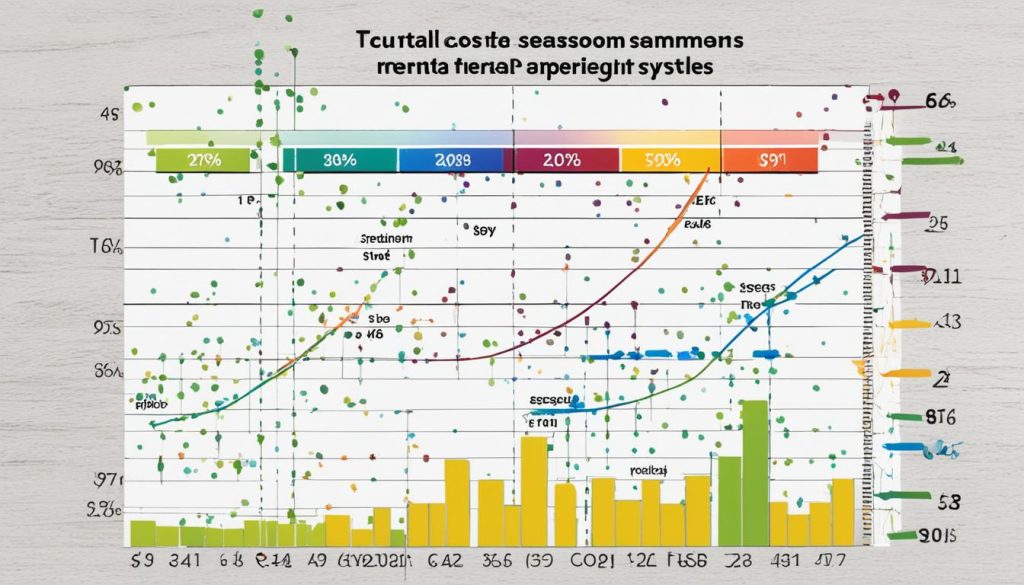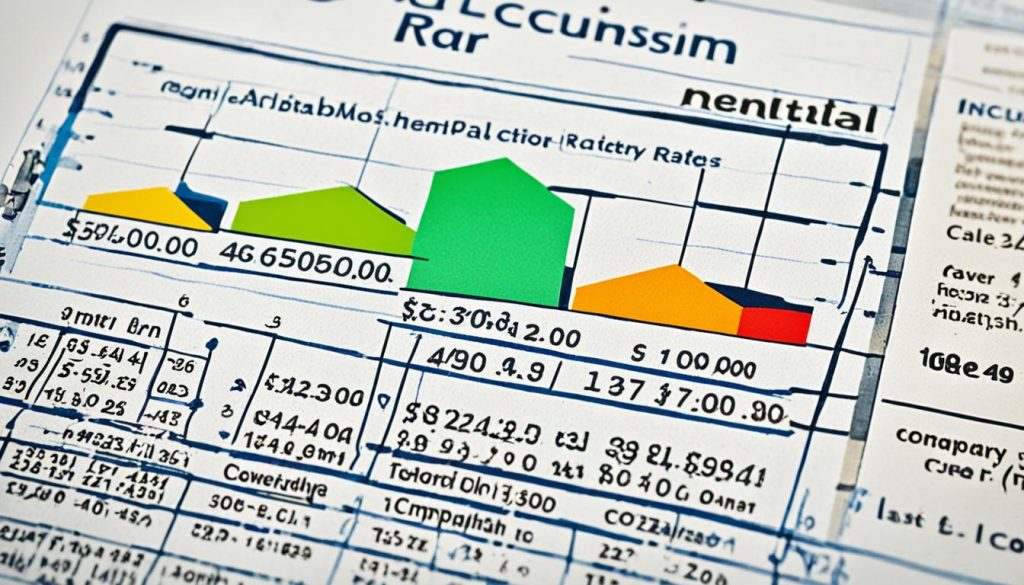Compare Rental Rates & Inclusions Easily!
gorvlifestyle.com and its partners may earn a commission if you purchase a product through one of our links
Securing a residence, whether for personal dwelling or as an investment, often entails discerning the best rental deals in a bustling and complex market. A comprehensive rental rates comparison and diligent rental inclusions analysis are the cornerstones of discovering the most advantageous leasing options. Guiding you through this process, this article illuminates how landlords and tenants alike can leverage a rent comparison tool to ensure fair and profitable rental agreements, informed by a deep understanding of how to compare rental rates and inclusions effectively.
Utilizing the tools and strategies outlined herein, readers will be equipped to navigate the rental market with ease, positioning themselves to uncover the hidden value within rental propositions. Whether you’re a seasoned investor or a first-time renter, gain the confidence needed to make astute rental decisions in today’s ever-fluctuating real estate landscapes.
Key Takeaways
- Understand the essentials of a rental rates comparison to secure the best rental deals.
- Use a rent comparison tool to efficiently assess property value against market standards.
- Discover the importance of a meticulous rental inclusions analysis in pricing strategy.
- Learn tips on how to compare rental rates & inclusions to make well-informed rental choices.
- Recognize the impact of market trends on achieving optimal rental agreements.
Evaluating Rental Value Based on Property Worth
For landlords and investors, the task of rental cost evaluation is a key aspect of real estate management. Determining the correct pricing for a property can be challenging, with various models and rules, such as the 1% rule, employed as starting points. Yet, understanding these models and recognizing exceptions becomes essential in comparing rental pricing accurately and conducting a thorough rental fees examination.
Understanding the 1% Rule and Its Exceptions
The 1% rule posits that a property’s monthly rent should be at least 1% of its upfront cost—providing a quick heuristic for investors when deciding on rental prices. This benchmark, while helpful, does not account for the unique characteristics of each property or the economic landscape of the area. As such, exceptions to this rule frequently arise, tailored to the property’s location, size, condition, and the current real estate market conditions.
National Average Rental Rates Versus Aggressive Pricing
Contrasting the 1% rule with national average rental rates unveils the variability in rental pricing strategies. Aggressive pricing might not be sustainable in every market. It is imperative for investors to analyze local data, considering factors such as population growth, employment rates, and average income, which all can significantly affect a property’s rental worth.
National averages can serve as an anchor for setting rental prices but must be adjusted to fit local economic situations. The data below reflects recent statistics which highlight the diversity in rental costs across different regions, emphasizing the importance of a custom approach over a fixed percentage rule when evaluating rent.
| Location | Average Rental Rate | Suggested 1% Rule Rate | Actual Pricing Strategy |
|---|---|---|---|
| Urban Areas | $1,500 | $1,400 | 0.9% – Adjusted for high demand |
| Suburban Areas | $1,200 | $1,000 | 0.8% – Reflective of accessibility |
| Rural Areas | $800 | $1,100 | 0.6% – Compensating for lower demand |
As highlighted, setting a rental price within the range of 0.8% to 1.1% of the property’s value can often provide a more nuanced approach, aligning the rate more closely with current rental market pressures and regional economic realities. This fosters a balance between competitive pricing and ensuring a profitable investment, essential in the sphere of real estate management.
The Rental Market Analysis: A Landlord’s Deep Dive
Conducting a thorough rental market analysis (RMA) signifies a landlord’s commitment to understanding and adapting to the evolving rental landscape. Gaining deep insights into the local real estate scene is imperative to execute a precise rental potential assessment.
This form of analysis evaluates numerous factors, including the average rental rates in the vicinity, the desirability of the neighborhood, and the value provided by similar properties. Savvy landlords look beyond surface-level data to understand the subtleties that dictate rental options comparison.
To start off, a neighborhood evaluation revolves around understanding the amenities, school districts, safety rankings, and overall demand in the area. Following that, landlords should look at properties equivalent in size, condition, and offerings to position their rental competitively.
Rental market nuances, such as proximity to public transportation or unique building amenities, can have considerable impact on a property’s rental allure and value.
Rent-per-square-foot calculations provide a standardized metric to compare properties of different sizes and types. Additionally, analyzing the amenities and restrictions through well-established platforms like Zillow helps landlords to identify what renters in a particular market are looking for and willing to pay.
Below is an example of a rental options comparison chart:
| Property Size | Average Rent | Average Rent per Sq Ft | Neighborhood Amenities |
|---|---|---|---|
| 1 Bedroom | $1,200 | $2.00 | Parks, groceries, cafes |
| 2 Bedroom | $1,800 | $1.80 | Parks, groceries, cafes, gym |
| 3 Bedroom | $2,400 | $1.60 | Parks, groceries, cafes, gym, pool |
To fine-tune the rental price point, successful landlords combine this quantifiable data with the less tangible elements of a property’s appeal. They might adjust their rental fees in response to the market’s seasonal shifts or capitalize on the scarcity of certain property features in the neighborhood.
Ultimately, a meticulous rental market analysis provides a data-driven foundation for establishing rental prices that reflect both a property’s worth and the dynamics of the local market, ensuring rental options are both competitive and profitable.
How to Compare Rental Rates & Inclusions
Embarking on the journey to find the perfect rental requires a roadmap to navigate through the diverse landscape of options available. For savvy landlords and tenants alike, mastering the art of rental rates comparison is tantamount to securing a deal that benefits all parties involved. Understanding the full spectrum of what a property offers stretches beyond just the sticker price—it’s a meticulous rental inclusions analysis that often tips the scales.
Utilizing Online Rent Comparison Tools
With technology at their fingertips, landlords have the luxury of leveraging online tools to compare rental rates effectively. Websites like Zillow serve as gateways to a repository of data, where inputting specifics such as square footage, location, and the number of bedrooms paints a more accurate picture of the rental landscape. These platforms distill complexity into simplicity, enabling comparisons that account for a kaleidoscope of factors defining each property’s value.
Breaking Down Inclusions: What Affects Rent Value?
The algebra of determining rent value isn’t confined to the physical dimensions of a space—it’s also about the added perks and amenities that can elevate a residence from just livable to highly desirable. Modern renters weigh the presence of luxuries like gyms, swimming pools, and on-site services heavily. For landlords, these are not mere amenities but rather strategic inclusions that can justify higher rental fees in line with current market trends and tenant expectations.
- Gyms and fitness centers
- In-unit washer and dryer
- Pet-friendly policies and areas
- Modernized kitchen appliances
- Security features
- Private outdoor space
- Proximity to public transportation
In conclusion, drilling down into the intricacies of both the tangible and intangible elements that collate to form a rental property’s worth is indispensable. But with the right tools and an in-depth analysis of inclusions, landlords can list their properties at rates that reflect their true value, and renters can make better-informed decisions that align with their lifestyle and budget.
Seasonal Variations and Their Impact on Rental Rates
As landlords and investors navigate the rental landscape, seasonal rental pricing emerges as a pivotal factor influencing potential revenue. The intricate dance of supply and demand shifts rhythmically with the changing seasons, as peak periods ebb and flow, affecting rental rates comparison. Understanding these cyclical patterns can be the key to maximizing income and minimizing vacancy rates.
Summer Highs and Winter Lows: When to List Your Rental
Summer months sparkle with opportunity for the rental market, bringing a surge in demand as people relocate to capitalize on the break in academic calendars and pleasant climate. This is the time when families, students, and individuals are most likely to seek new accommodations. Consequently, the summer season is often marked by a spike in rental rates comparison, as landlords can command premium pricing for their properties.
Renter Demand Fluctuations Throughout the Year
Unlike the burgeoning summer, winter’s chill tends to cool the rental market, leading to a conspicuous dip in demand. As fewer tenants are looking to move, landlords might find themselves comparing rental pricing against an increasing number of unoccupied units, prompting them to consider reducing rents or offering incentives to attract renters during these slower months.

To illustrate the impacts of seasonality, the following table compares the average rental rates during high-demand summer months to the more relaxed winter period. Data is synthesized from key rental platforms to underscore the importance of timing in the rental industry.
| Month | Avg. Rental Rate (Summer) | Avg. Rental Rate (Winter) | Percentage Difference |
|---|---|---|---|
| June | $1,500 | – | – |
| July | $1,530 | – | – |
| August | $1,550 | – | – |
| December | – | $1,400 | – |
| January | – | $1,380 | – |
| February | – | $1,370 | – |
As depicted, landlords and property managers can benefit from more aggressive pricing during June, July, and August when the demand is at its peak, therefore optimizing their earning potential. However, things take a turn during the colder times, and having a dynamic pricing strategy is essential to remain competitive while attempting to fill vacancies.
Closely monitoring these seasonal rental pricing trends is an indispensable element of a successful rental business strategy. By comparing rental pricing and adjusting to seasonal demand, landlords can make informed decisions to list their properties at optimal times, ensuring a thriving balance between tenancy rates and income throughout the year.
Understanding Rent Control and Its Effects
Across the United States, rent control laws present a significant factor in shaping the rental landscape. This set of laws, which is not uniformly adopted nationwide, functions to stabilize or limit how much rent can be increased over time, thus ensuring a degree of protection for tenants. In highly competitive housing markets, understanding the extent and nuances of rent control regulations is a crucial component of a holistic rental market analysis.
Specifically, in markets such as California and New York, rent control laws can have a marked influence on how landlords approach setting and raising rental rates. These laws are designed not only to keep housing affordable but also to provide a buffer against rapid inflation in housing costs that could displace long-term residents. To landlords, this means a need to stay informed and compliant with local ordinances when calculating potential returns on rental properties, particularly when conducting a rental rates comparison with non-rent-controlled units.
In cities where rent control laws are in effect, the permissible rental increase is typically set each year. For instance, Los Angeles has a Rent Stabilization Ordinance (RSO) which allows landlords to increase rent by only a certain percentage annually, tied to the Consumer Price Index. To give a clearer picture, consider the following table illustrating hypothetical rental caps in several municipalities:
| City | Annual Rental Cap Increase | Additional Tenant Protections |
|---|---|---|
| San Francisco, CA | 60% of CPI, not exceeding 7% | Just Cause Eviction Laws |
| Los Angeles, CA | 3-8% (Dependent on CPI) | Relocation Assistance |
| New York, NY | 0-3% (Decided by Rent Guidelines Board) | Lease Renewal Guarantees |
As can be seen, these unique constraints necessitate careful and informed strategies by property owners to balance being competitive while remaining lawful. Landlords must consider these caps has a fixed component of their revenue projections, influencing not just how much they can charge, but also the value of property improvements and long-term investment plans.
Additionally, while rent control can make certain cities less attractive investment opportunities due to potential limitations on rental income growth, it can also mean greater stability in tenant occupancy rates. Reliable, long-term residents might be more achievable in rent-controlled properties, which can be factored into overall projections for property performance.
In essence, rent control laws create a unique economic environment for the rental market. They are a double-edged sword that requires landlords and investors to keenly understand and adapt their strategies accordingly. This understanding is crucial for achieving optimal balance in such regulatory climates and for preventing any unscheduled losses or legal complications arising from non-compliance.
Financial Considerations for Setting Rental Prices
Delving into the financial planning for landlords, a thorough rental cost evaluation is essential in forging the path to profitability. Beyond the monthly rent checks, there’s an array of expenses that must be carefully balanced against income. A comprehensive rental market analysis serves as the foundation for this financial equilibrium.

To ensure that the fiscal facets of property management don’t spiral into daunting surprises, the savvy landlord must include a litany of costs into their financial framework. This includes not just the obvious mortgage and maintenance expenses, but also prepares for the less frequent but equally impactful outlays.
- Mortgage repayments form the backbone of financial obligations, often consuming the largest slice of rental income.
- Upkeep is a crucial, ongoing cost, extending from routine maintenance to emergency repairs.
- Property taxes and insurance are mandatory expenditures, varying significantly by location and coverage choices.
The rule of thumb is that the rent should not only cover these costs but also offer a buffer for unpredicted expenses. This is where a cushion, or a profit margin, becomes part of smart financial planning.
| Expense Category | Expected Costs | Notes |
|---|---|---|
| Mortgage | $1,200/month | Based on principal and interest |
| Maintenance | $150/month | Includes minor repairs and landscaping |
| Property Taxes | $300/month | Based on local tax rates |
| Insurance | $100/month | Varies by policy details |
| Profit Margin | 20% of income | For unforeseen costs and savings |
Seasonal impacts also deserve attention in this financial strategy. For instance, heating costs may spike in the winter, while vacancy rates might climb during the summer. The ideal rental price will reflect these variances and secure year-round stability.
Ultimately, getting the numbers right is a balancing act that demands continual attention but rewards with sustained profitability and investment protection.
Insights into Recent Rental Rate Trends
The last few years have brought about transformative change within the rental market, often attributed to ramifications from the pandemic. Policy adjustments, economic shifts, and changes in tenant priorities have all contributed to a new landscape that we’re only just beginning to understand. Let’s examine the latest data and understand the trends shaping the affordability and availability of rental properties.
Assessing the Pandemic’s Influence on Rental Costs
The unprecedented global health crisis undeniably sent ripples through the housing market. Rental rates analysis indicates a consequential swell in rental costs across many urban and suburban areas. In parallel, the pandemic rental trends suggest an unexpected surge in the demand for single-family homes, a reaction possibly tied to shifts toward remote work and the search for more spacious living environments.
Rental Affordability: Historical Context and Future Projections
Understanding the concept of affordability assessment is crucial when evaluating the historical context of rental rates. Prior to the pandemic, rent growth often correlated closely with inflation and wage increases. However, recent market conditions have disrupted this balance, leading to the need for more nuanced projections about future rent affordability. Prolonged trends suggest a disparity that could stretch the budgets of many American households.
| Year | Single-Family Home Rent Growth | Multifamily Home Rent Growth | Economic Growth |
|---|---|---|---|
| 2019 | 3.3% | 2.8% | 2.2% |
| 2020 | 3.8% | 1.1% | -3.5% |
| 2021 | 7.8% | 6.3% | 5.7% |
The table above paints a picture of the shifting dynamics in rental rates as influenced by both the housing type and economic circumstances. While historical data serves as a reference, investors and renters alike are increasingly relying on nuanced insights that factor in regional variance and predictions for gradual normalization of growth rates.
In the coming years, we will likely see a continued but slower increase in rental rates, driven by market adaptations and the ongoing effects of the pandemic. The rental market is a critical piece of the housing economy, and as thus, its fluctuations merit close observation for anyone connected to the world of real estate.
Rental Property Characteristics Influencing Price Points
The allure and pricing of rental properties are significantly impacted by their rental property features. A well-positioned home with modern upgrade value and amenities can substantially enhance the amenity impact on rental rates, attracting tenants willing to pay more for superior facilities and convenience. Understanding which characteristics impact pricing most can help landlords maximize their returns.
Upgrades and Amenities: Advantageous Rent Boosters
From smart home technology to eco-friendly appliances, the types of upgrades and amenities offered in a rental property can act as significant rent boosters. As renters become more discerning, features that offer convenience, security, and lifestyle enhancements are increasingly in demand. Landlords who invest in quality upgrades can expect to see a return in the form of higher rental rates.
The Leasehold Upgrades Agreement: A Cost-Benefit Analysis
Striking a balance between making profitable upgrades and those that tenants will pay more for is crucial. Leasehold improvement agreements can be a practical solution, where tenants contribute to the upgrade costs in exchange for amenities that meet their specific needs. This arrangement often works in favor of both parties, offering tenants a customized living experience and landlords an avenue to increase their property’s market value.
| Amenity | Typical Cost | Expected Increase in Rental Value |
|---|---|---|
| In-unit washer and dryer | $1,000 – $2,000 | 5-10% |
| High-end kitchen appliances | $3,000 – $10,000 | 10-15% |
| Smart home technology | $500 – $2,500 | 3-7% |
| Hardwood flooring | $5 – $10 per sq ft | 6-12% |
| Parking space | $100 – $200 per month | 8-10% |
| On-site fitness center | $10,000 – $50,000 | 15-20% |
Interpreting Rental Data from Key Economic Indicators
As investors and property managers navigate the complexities of the real estate market, understanding the relationship between rental economic indicators and broader economic forces is essential. A keen analysis of these elements can illuminate potential trends in housing demand and rental price adjustments. Particularly significant is the inflation impact on rent, which serves as both a reflection and a predictor of financial health within the housing sector and the overall economy.
Rent Prices Versus Inflation Rates: The Economic Link
Rental prices are not isolated in their fluctuation; they are fundamentally connected to inflation rates. The data compiled by the Bureau of Labor Statistics indicates that as rent prices increase, they contribute markedly to the consumer price index, signaling an inflationary trend in the economy. This correlation highlights the need for landlords to stay informed on inflation impact on rent to anticipate adjustments in their rental pricing strategies.
Contribution of Rent Costs to National Economic Trends
The sway of rent costs on national economic trends cannot be overstated. When rents rise, they can reverberate through the economy, influencing consumer spending and the overall cost of living. Therefore, trend analysis in rental markets is not just about pricing properties effectively; it is about grasping the larger economic picture that frames the future of renting, homeownership, and investment.
Comparative Rent Analysis: A Guide to Market Dynamics
The art of setting the right rental price is a critical aspect of property management. Adept landlords and real estate professionals employ a comparative rent analysis to ensure their pricing strategies keep pace with the current market trend evaluation. This analytical tactic involves an in-depth look at similar offerings in the vicinity, providing a solid framework for sustaining competitive rental pricing strategies.

Conducting this analysis is akin to compiling a real estate encyclopedia specific to a given location—it’s thorough, detailed, and tailored. Square footage, the number of bedrooms and bathrooms, and especially property location act as baseline variables. However, the savvy analyst doesn’t stop there. A deep dive into property features such as recent renovations or luxury inclusions gives a clearer perspective on the premium a rental can command. These details can transform an average property into an elite rental proposition.
Market Variability is another pillar of comparative analysis. The ebb and flow of regional demand and broader economic health can cause seismic shifts in rental value. It’s imperative for property managers to use analytical foresight to not just react to, but anticipate such fluctuations, thereby optimizing rental income.
- Evaluating Market Trends — Is the area on an upward trajectory, or is the market cooling down?
- Regional Demand — Are people moving in or out of the neighborhood, and why?
- Socioeconomic Links — How do local employment rates and economic conditions affect rental demand?
By dissecting and understanding these components, landlords and investors can establish a dynamic pricing model that adapts to market whims—securing profitability and tenant satisfaction in equal measure. Whether a seasoned investor or a budding landlord, harnessing these insights is paramount for successful rental property management.
A comprehensive rent analysis doesn’t stand alone; it works in tandem with continuous market trend evaluation. Practitioners of this science not only compare but also predict—crafting robust rental strategies resilient to market vagaries. When rental pricing strategies are informed by a meticulous comparative rent analysis, they resonate with the cadence of the fluctuating real estate symphony, striking a chord with market dynamics and tenant expectations alike.
Rent Versus Income: Assessing Household Affordability
As rental costs continue to escalate, understanding the balance between rent and personal income is essential for both tenants and landlords. The concept of household rental affordability revolves around the rent-to-income ratio, a vital metric indicating the percentage of gross income allotted to rent expenditures. A prudent benchmark is that rent should not exceed 30% of a household’s gross income. This guideline is pivotal to avoid the categorization of being financially burdened by housing costs. However, the consistent rise in rental prices has been challenging this standard, pushing more renters to stretch their budgets perilously thin.
Cost of living considerations also extend beyond mere rental fees. In today’s economic climate, additional living expenses, such as utilities, transportation, and health care, can further impact one’s ability to maintain rental affordability. Landlords, when determining rental prices, must take into account local wage trends and the general financial health of the community. Establishing rental fees that are congruent with the area’s average income helps in ensuring that tenants are not overburdened, and consequently reduces turnover and vacancies, fostering a stable tenant base.
Ultimately, the implications of setting a rental price that exceeds the recommended rent-to-income threshold can be profound. It affects not only the financial stability of renters but the overall market sustainability. Landlords and property managers must balance the drive for profitability with a conscientious assessment of what is realistically manageable for their tenants. By doing so, they can secure long-term occupancy and maintain a reliable income stream, contributing positively to the broader housing ecosystem.






